-
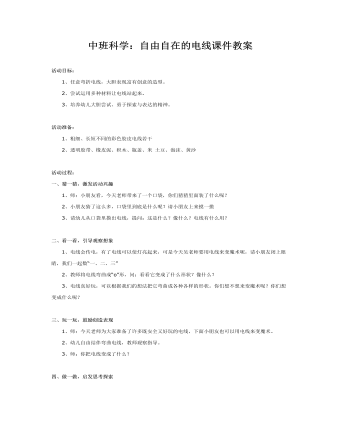
中班科学:自由自在的电线课件教案
2、尝试运用多种材料让电线站起来。3、培养幼儿大胆尝试、勇于探索与表达的精神。 活动准备:1、粗细、长短不同的彩色胶皮电线若干2、透明胶带、橡皮泥、积木、瓶盖、米土豆、泡沫、黄沙 活动过程:一、猜一猜,激发活动兴趣1、师:小朋友看,今天老师带来了一个口袋,你们猜猜里面装了什么呢?2、小朋友猜了这么多,口袋里到底是什么呢?请小朋友上来摸一摸3、请幼儿从口袋里摸出电线,提问:这是什么?像什么?电线有什么用?
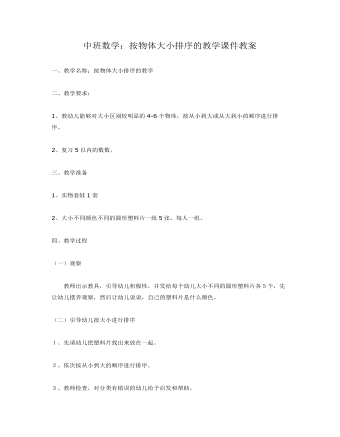
中班数学:按物体大小排序的教学课件教案
二、教学要求:1、教幼儿能够对大小区别较明显的4-6个物体,按从小到大或从大到小的顺序进行排序。2、复习5以内的数数。三、教学准备1、实物套娃1套2、大小不同颜色不同的圆形塑料片一组5张,每人一组。

中班主题课件教案:动物的特殊本领
活动目的:1. 通过探索与交流活动,让幼儿了解常见动物的本领。2. 培养幼儿爱提问,乐于收集资料等主动学习的能力。活动准备:动物图书、电脑课件;电视、幻灯机、2块大黑板 幼儿调查表每人一张活动指导:一、 故事“想飞的小象”引入,组织幼儿边看故事边听故事。二、 故事后提问,让幼儿谈谈听完这个故事他们了解了什么?故事里的小动物有哪些本领?逸晨:每一种动物都有自己的本领,不能互相比较。陈铭:不同的动物有不同的本领由此,教师引出了“动物的本领”这一话题三、 幼儿每人拿出自己的调查表并互相交流他们所了解的动物的本领。小洁:骆驼是沙漠之舟张蕾:信鸽会送信宇昕:大象长长的鼻子会运木头若仪:蜜蜂会采花蜜逸如:老虎会用尖尖的牙齿咬人通过这个环节,教师发现孩子们互相交流时都很积极,集中提问时孩子们都能踊跃发言,显然,孩子们对“动物的本领”这个话题是十分有兴趣的。
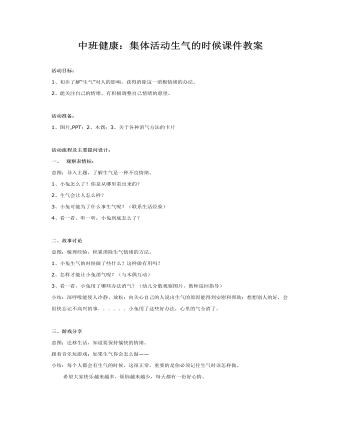
中班健康:集体活动生气的时候课件教案
2、能关注自己的情绪,有积极调整自己情绪的愿望。 活动准备:1、图片,PPT;2、木偶;3、关于各种消气方法的卡片 活动流程及主要提问设计:一、 观察表情标: 意图:导入主题,了解生气是一种不良情绪。1、小兔怎么了?你是从哪里看出来的?2、生气会让人怎么样?3、小兔可能为了什么事生气呢?(联系生活经验)4、看一看、听一听,小兔到底怎么了?
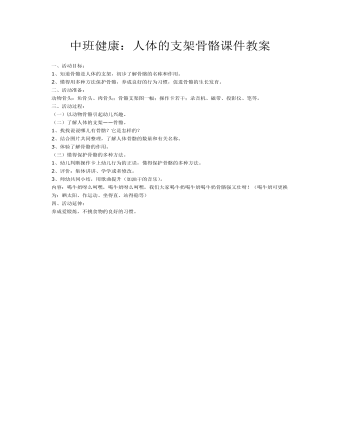
中班健康:人体的支架骨骼课件教案
2、懂得用多种方法保护骨骼,养成良好的行为习惯,促进骨骼的生长发育。 二、活动准备:动物骨头:鱼骨头、肉骨头;骨骼支架图一幅;操作卡若干;录音机、磁带、投影仪、笔等。三、活动过程: (一)以动物骨骼引起幼儿兴趣。(二)了解人体的支架——骨骼。 1、找找说说哪儿有骨骼?它是怎样的?2、结合图片共同整理,了解人体骨骼的数量和有关名称。3、体验了解骨骼的作用。
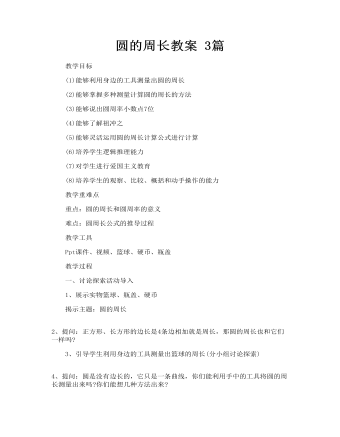
圆的周长教案 3篇
一、讨论探索活动导入 1、展示实物篮球、瓶盖、硬币 揭示主题:圆的周长 2、提问:正方形、长方形的边长是4条边相加就是周长,那圆的周长也和它们一样吗? 3、引导学生利用身边的工具测量出篮球的周长(分小组讨论探索) 4、提问:圆是没有边长的,它只是一条曲线,你们能利用手中的工具将圆的周长测量出来吗?你们能想几种方法出来?

《飞的更高》教案
教学过程一、创设情境导入。先弹奏一遍《飞得更高》的音乐,吸引同学们的兴趣。师:同学们以前有没有听过汪峰的歌曲?感觉它的风格是什么样的?(《怒放的生命》,摇滚型歌手)生:……师:同学们以前有没有听过这首歌?听完这首歌有什么样的感受?生:励志、向上、振奋……师:想象一下这首歌所呈现的画面。(歌曲像一条大河,缓缓流过,起初平静,时而急流时而狭窄,逐渐开阔。如同生命。听者会被带入一种境界,如同站在网中漫步一片辽阔的旷野,雄鹰在头顶的天空翱翔,令心中有一种欲望在疯长,无法遏止。)

人教版高中地理选修1第二章第二节月球和地月系教案
我们将三球仪中的月球放在地球和太阳之间时,对照“月相成因图”,它的暗面完全对着地球,而被太阳照亮的一面正对着太阳,我们看不到月亮,这时正是农历初一,被称为“新月”。又称为“朔”。 过了新月,月亮被照亮的部分慢慢地转向地球。当它从太阳的光辉中出现时,便出现了一丝蛾眉的弯月,此时为农历的初三、初四,因其形似蛾眉,被称为“蛾眉月”。此后,被太阳光照亮的部分越来越多地转向地球,当有一半亮面和一半暗面都对着地球时,明亮部分和黑暗部分的界线似乎像一张弓中没有拉动的弦。此时是夏历初七、初八,称为“上弦月”。这时月亮很明亮,有时在白天也能看见。在往后,月亮明亮部分越来越增大,当它转到与新月正好相反时,被太阳照亮的部分全都对着地球,看起来月亮就似一轮圆月,此时正是 农历十五、十六、十七,称为“满月”,又称为“望”。
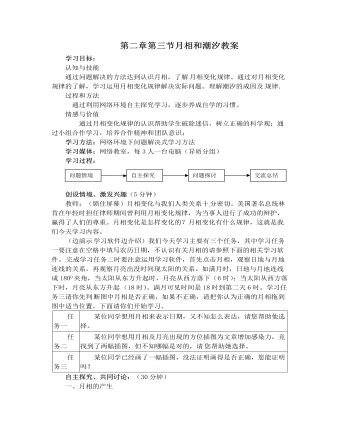
人教版高中地理选修1第二章第三节月相和潮汐教案
创设情境、激发兴趣(5分钟)教师:(锁住屏幕)月相变化与我们人类关系十 分密切。美国著名总统林肯在年轻时担任律师期间曾利用月相变化规律,为当事人进行了成功的辩护,赢得了人们的尊重。月相变化是怎样变化的?月相变化有什么规律,这就是我们今天学习内容。(边演示 学习软件边介绍)我们今天学习主要有三个任务,其中学习任务一要注意在空格中填写农历日期,不认识有关月相的请参照下面的相关学习软件。 完成学习任务二时要注意运用学习软件,首先点击月相,观察日地与月地连线的关系,再观察月亮出没时间现太阳的关系。如满月时,日地与月地连线成1800夹角,当太阳从东方升起时,月亮从西方落下(6时);当太阳从西方落下时,月亮从东方升起 (18时)。满月可见时间是18时到第二天6时。学习任务三请你先判 断图中月相是否正确,如果不正确,请把你认为正确的月相拖到图中适当位置。下面请你们开始学习。
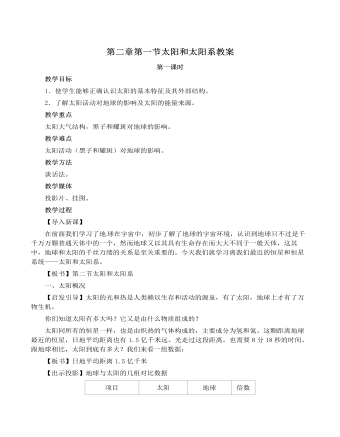
人教版高中地理选修1第二章第一节太阳和太阳系教案
教学过程【导入新课】在太阳系中,九大行星就好像一个家庭中的九个兄弟,有许多共性,今天,我们就一起来了解九大行星在运动特征和结构特征上的共同之处。【板书】3.九大行星的运动特征和结构特征【启发引导】请同学们一起阅读地图册上的“太阳系模式图”,读图分析:(1)九大行星在公转的方向、轨道等方面有什么共性?(2)图中符号“i”、“e”代表什么意思?这两组数字能说明什么问题?九大行星公转的方向相同,均为自西向东转,我们称为同向性。符号“i”表示轨道倾角。(简介黄道、黄道面、轨道倾角)各大 行星的轨道倾角都很小,只有水星和冥王星的大一些,最大也不过17°,说明九大行星的公转轨道近似在同一个平面上,我们称之为共面性。符号“e”代表公转轨道椭圆的偏心率,即焦点到椭圆中心的距离与椭圆半长轴之比,它决定椭圆的形状。偏心率越小,越趋向于圆,当偏心率为0时,轨道就是圆。

《你是这样的人》教案
教学课题:1、欣赏并演唱《你是这样的人》。2、欣赏并朗诵表现总理的诗歌。3、跟老师唱《为了谁》,从中感受英雄人物的无私奉献精神。教学目标:1、能饱含深情地演唱《你是这样的人》,体验表现对周总理的怀念崇敬之情。2、感受诗歌如何塑造总理的光辉形象。3、通过演唱歌曲,感受英雄人物的无私奉献精神,从而感悟人生、树立正确的世界观和人生观。教学分析:这是大型电视艺术片《百年恩来》的主题歌。歌曲分为两个部分。第一部分:旋律委婉深情,节奏平稳规整,把一个伟人沉稳的形象表现得淋漓尽致。这一主题在第二部分中也多次出现,使两部分紧紧相扣。第二部分:表达了对伟人的无限怀念。这首歌在创作风格上一改过去歌颂伟人的模式,旋律以深沉、凝重见长,歌词也以抒情为主。以“人之情”替代了口号似的语言,仿佛周总理那微笑的神情又展现在我们面前,总理博爱的精神和博大的胸怀影响着一代又一代人。
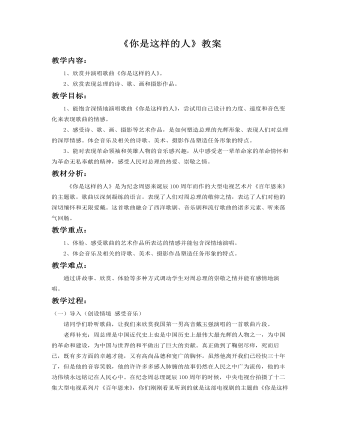
《你是这样的人》教案
教学内容:1、欣赏并演唱歌曲《你是这样的人》。2、欣赏表现总理的诗、歌、画和摄影作品。教学目标:1、能饱含深情地演唱歌曲《你是这样的人》,尝试用自己设计的力度、速度和音色变化来表现歌曲的情感。2、感受诗、歌、画、摄影等艺术作品,是如何塑造总理的光辉形象、表现人们对总理的深厚情感。体会音乐及相关的诗歌、美术、摄影作品塑造任务形象的特点。3、能对表现革命领袖和英雄人物的音乐感兴趣,从中感受老一辈革命家的革命情怀和为革命无私奉献的精神,感受人民对总理的热爱、崇敬之情。教材分析:《你是这样的人》是为纪念周恩来诞辰100周年而作的大型电视艺术片《百年恩来》的主题歌。歌曲以深刻凝练的语言。表现了人们对周总理的敬仰之情,表达了人们对他的深切缅怀和无限爱戴。这首歌曲融合了西洋歌剧、音乐剧和流行歌曲的诸多元素、听来荡气回肠。
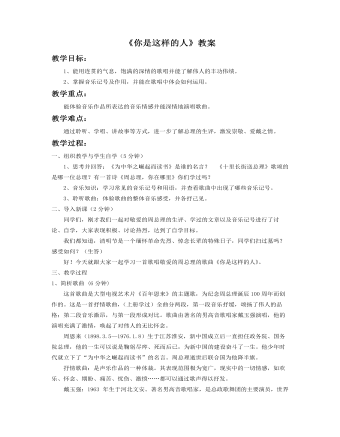
《你是这样的人》教案
简析歌曲 (6分钟)这首歌曲是大型电视艺术片《百年恩来》的主题歌,为纪念周总理诞辰100周年而创作的。这是一首抒情歌曲,(上册学过)全曲分两段,第一段音乐抒缓,颂扬了伟人的品格;第二段音乐激昂,与第一段形成对比。歌曲由著名的男高音歌唱家戴玉强演唱,他的演唱充满了激情,唤起了对伟人的无比怀念。周恩来(1898.3.5—1976.1.8)生于江苏淮安,新中国成立后一直担任政务院、国务院总理,他的一生可以说是鞠躬尽瘁、死而后已,为新中国的建设奋斗了一生。他少年时代就立下了“为中华之崛起而读书”的名言。周总理逝世后联合国为他降半旗。抒情歌曲:是声乐作品的一种体裁。其表现范围极为宽广,现实中的一切情感,如欢乐、怀念、期盼、痛苦、忧伤、激愤……都可以通过歌声得以抒发。

人教版高中地理选修2国土整治与区域开发教案
【考点搜索】理解中国国土整治的必要性、主要内容及其与区域可持续发展的关系。【教材分析】本课是我国国土整治与区域发展的一个开篇,目的是让学生了解国土整治的概念、意义、我国进行国土整治的必要性和迫切性、我国国土整治的重点工程、国土整治与区域发展的关系。使学生了解我国实施国土整治与区域发展的一些基本理论和原则,为以后各单元讨论典型地区的国土整治与区域发展奠定理论基础。◆重要图释1、图2.2“中国防护林体系规划示意图”防护林体系工程是中国生态工程建设的基本框架,覆盖了我国主要水土流失区、风沙危害区、盐碱区和台风区。图中深绿色区域为“三北”防护林体系建设规划区、浅绿色区域为长江中上游防护林体系建设规划区、紫色区域为沿海防护林体系建设规划区。其中“三北”防护林体系工程是世界最大的生态工程。

人教版新目标初中英语九年级上册Where would you like to visit教案2篇
The First PeriodⅠ.Teaching Aims and DemandsKnowledge Objects(1) Key Vocabularytiring, educational, fascinating, thrilling, peaceful, exotic, trek, jungle, take it easy, explore, historic, site(2) Target LanguageWhere would you like to go on vacation?I’d like to trek through the jungle, because I like exciting vacations.2. Ability Objects(1)Train students to talk about places they would like to visit with the target language.(2)Train students to describe vacations with different adjectives.(3)Train students' listening skill.3. Moral Object,It′s more interesting to go on vacating somewhere instead of staying at home.Ⅱ. Teaching Key Points1. Key Vocabularytiring, educational, fascinating, thrilling, peaceful, exotic, trek, jungle, take it easy, explore, historic, site2. Target LanguageTalk about different places with the target language.Ⅲ. Teaching Difficult Points1. Describe vacations with different adjectives.2. Talk about different places with the target language.Ⅳ. Teaching Methods1. Teaching by illumination2. Teaching by doing chain drills3. Teaching by pairworkⅤ. Teaching Aids1. A tape recorder2. Some pictures of different places with famous views

人教版新目标初中英语七年级下册How was your weekend教案2篇
Teaching Goal:1. General aims:Talk about recent past events2. Particular aims:A. Language Focus.Talk about recent past events and think of the past events.B. Language goalsHow was….?It was …What did …do over the weekend?C. Language structures:(1). How was your weekend? I was great. Pay attention to no form.(2). What did you do over the weekend? I played soccer. We went to the beach.D. Useful words and phrases:Words: was, did, went, beach, over, project, test, wasn’t, false, number, geography, spend, week, most, mixture, their, had, little, cook, read, saw, change, everyone, sit, sat, no, anythingPhrases: did one’s homework, played soccer, cleaned my room, went to the beach, played tennis, went to the movies, on Saturday morning, over the weekend, cook … for, what about, do some reading, have a party, talk show, go shoppingE. Grammar language:Present simple past tenseRegular and irregular verbsF. Learning strategies:Tour and holidaysG. Interdiscipinary:H. Emotion and manner:Teaching time: 5 periodsTeaching procedures:Period One教学步骤、时间 教师活动 学生活动 媒体应用Step 1Free talk 3’ Ask some questions like:Who’s on duty today?What’s the weather like? Answer and talk about something.让同学们回答下列问题1. Do you like weekend? (Let some students answer)It takes them three minutes to talk about the question.2. Why do you like weekend? (let the students answer) Most of the students like the weekend此时教师用汉语问:“在周末期间问你干了什么?这句话用英语这么回答?Let the students guess.At last the teacher give them right answer3. What did you do over the weekend?(板书、学习)

人教版新目标初中英语七年级下册Where is the post office教案2篇
Period 2 (3a----Section B 2c)Preview(Pre-task): Key points: What laAdd another information about their pen pals----their language on the cardnguage does she/he speak?She/He speaks....Does she/he have any brothers and sisters? Does she/he speak English?Preview(Pre-task): Add another information about their pen pals----their language on the cardKey points: What language does she/he speak?She/He speaks....Does she/he have any brothers and sisters? Does she/he speak English?Step 1 Revision1.Revisionand dictation of the new words 2.Revise the drills they learned yesterday.(by pairwork and grammar exercise)Step 2 Leading-inT has a conversation with one student. The conversation is following:---Do you have a pen pal?---Yes, I do.---What's your pen pal's name? ---His/Her name is....---Where is your pen pal from? ---He/She is from...---Where does he/she live? ---He/She lives in....---What language does he/she speak?He/She speaks...Write the new words on the Bb. They are following: EnglishChineseJapaneseFrenchStep 3 LearnLearn the new words with the whole class.Finish 3a with the students3b Pairwork T still does an example with one student Then the Ss practise in pairs. The example is following:--Curry Muray is my pen pal. He is from the United States.---What language does he speak?

人教版新目标初中英语七年级下册Don’t eat in class教案2篇
Don’t fight. =You can’t fight. (板书,教读)教师把这些句子板书在黑板上,并请学生大声整齐地读祈使句和“can’t”句型,并让学生注意两种句型表达形式的不同和转换,“Don’t …=You can’t…”;并对学生说:These are our school rules. (板书,教读) You can’t break the school rules. Don’t break the school rules.(板书,教读)步骤3 :Practicea. T: Now, each of the students is breaking one of these rules.Please finish 1a.学生看图,完成1a的内容,检查答案并大声朗读校规。b. 听录音,完成1b,选出四位学生都违反了哪条校规;听之前,学生要读会英文名。c. 请两位学生朗读1c部分的句型;要求学生两人一组对话表演,SA扮演外校转来新生,SB告知本校校规。(学生可经过讨论,多说出他们想到的校规,不必只限于书上;教师应给予帮助)2) 第二课时(2a~4)步骤1 :warming up of revisionT: What are the rules at your school?学生使用“can”或祈使句表达各条校规;其中老师可引出“eat in the cafeteria outside”的表达。步骤2 :Practicea.T: Christina is an exchange student. She doesn’t know the rules. Let’s listen, what activities they’re talking about?学生听第一遍时,完成2a;第二遍时,完成2b;b. 请学生领读2c部分,看着2a完成的表格,理解2c活动的要求;分成小组针对2a进行问答;

人教版新目标初中英语七年级下册I want to be an actor教案2篇
三、教学建议第一课时:1. Lead in (Vocabulary)A) Before class, teacher should collect some pictures of working places. For example: Bank, TV Station, Restaurant, Police Station, Hospital ...B) In class, show students the pictures (PowerPoint, OHP). Ask students to tell the name of the working places and the name of the jobs.Shop assistant, doctor, actor, reporter, police office, waiter, bank clerk, studentC) Do exercise 1a and 3a.2. Bingo GameAsk groups of students to make up pairs of cards with a job on one and the related workplace on the other. For example, waiter / restaurant, teacher / school, doctor / hospital. Encourage students to use both the job / workplace combinations in the book and the ones that students came up during class discussions. Be sure they have twice as many sets of cards as there are students in the group. They can make two sets of cards for a single job / workplace, if necessary. Then have each group mix up its set of cards and hand their cards out in random order. Each time a student gets a pair of cards that match, he or she can lay these cards down. The goal is to have no cards in your hand at the end.3. Task OneA) Ask students to work in pairs and ask the partner what does he / she want to be in the future.e. g. :What do you / does he / does she want to be?I want to be a.Why?Because it's (adj).B) Vocabulary: Section B, 1a4. Homework 1.2.

人教版新目标初中英语七年级下册It’s raining教案2篇
1 Each group choose one place to describe and what you are doing in it Choose one place, and describe what they are doing 2 Move around the room and give suggestions Talk about it and write it down 3 Ask one to show their works and act it Choose one of each group to make a report 4 Evaluate the best group and the best reporter Choose the best one Homework Ask your friends their ideal place and write about it教学反思:新课程标准中强调学生在课堂中的主体地位,在综合课中他们的主体地位就更加突出。在各个活动中给不同程度的学生不同层次的任务,让各层面的学生都有表现发挥的机会,从而产生对英语的兴趣。使用照片图片多媒体来辅助教学,效果更好。同时让了解其他国家风景,风俗的同学介绍ideal place,增加学生的背景知知识,实现跨学科交流的目的。教案点评:采用任务型教学模式,在各个活动中给不同程度的学生不同层次的任务,让各层面的学生都有表现发挥的机会,从而产生对英语的兴趣。使用照片图片多媒体来辅助教学,效果更好。让了解其他国家风景,风俗的同学介绍ideal place,增加学生的背景知识,实现跨学科交流的目的。

